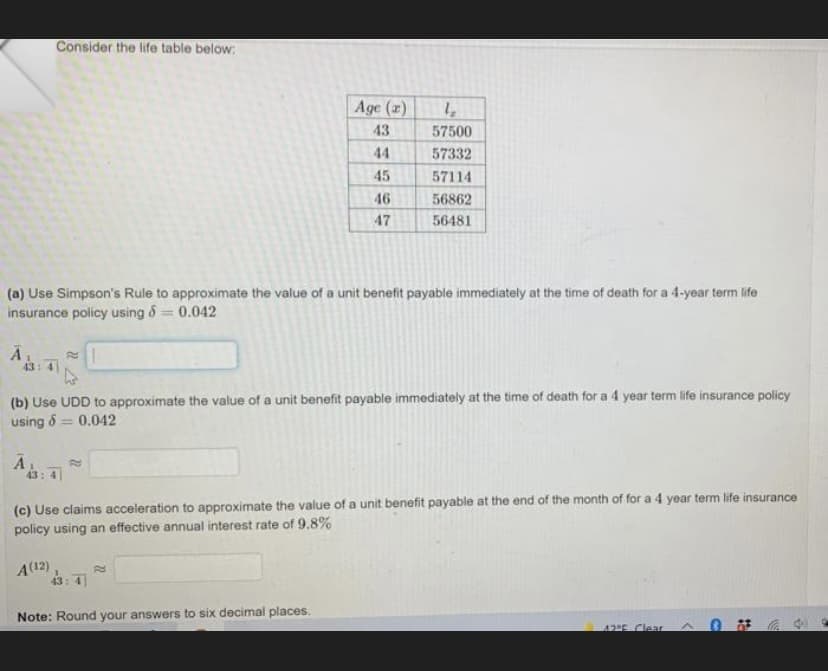Consider the life table below: Age (z) 43 57500 44 57332 45 57114 46 56862 47 56481 ) Use Simpson's Rule to approximate the value of a unit benefit payable immediately at the time of death for a 4-year term life msurance policy using 6= 0.042 43: 4 b) Use UDD to approximate the value of a unit benefit payable immediately at the time of death for a 4 year term life insurance policy using 6 0.042 %3D 22
Consider the life table below: Age (z) 43 57500 44 57332 45 57114 46 56862 47 56481 ) Use Simpson's Rule to approximate the value of a unit benefit payable immediately at the time of death for a 4-year term life msurance policy using 6= 0.042 43: 4 b) Use UDD to approximate the value of a unit benefit payable immediately at the time of death for a 4 year term life insurance policy using 6 0.042 %3D 22
Algebra & Trigonometry with Analytic Geometry
13th Edition
ISBN:9781133382119
Author:Swokowski
Publisher:Swokowski
Chapter5: Inverse, Exponential, And Logarithmic Functions
Section5.3: The Natural Exponential Function
Problem 40E
Related questions
Question

Transcribed Image Text:Consider the life table below:
Age (z)
43
57500
44
57332
45
57114
46
56862
47
56481
(a) Use Simpson's Rule to approximate the value of a unit benefit payable immediately at the time of death for a 4-year term life
insurance policy using 6 = 0.042
43: 4
(b) Use UDD to approximate the value of a unit benefit payable immediately at the time of death for a 4 year term life insurance policy
using 6 = 0.042
43: 4
(c) Use claims acceleration to approximate the value of a unit benefit payable at the end of the month of for a 4 year term life insurance
policy using an effective annual interest rate of 9.8%
A(12)
43:4
2
Note: Round your answers to six decimal places.
42E Clear
Expert Solution
This question has been solved!
Explore an expertly crafted, step-by-step solution for a thorough understanding of key concepts.
Step by step
Solved in 3 steps

Recommended textbooks for you

Algebra & Trigonometry with Analytic Geometry
Algebra
ISBN:
9781133382119
Author:
Swokowski
Publisher:
Cengage


Trigonometry (MindTap Course List)
Trigonometry
ISBN:
9781337278461
Author:
Ron Larson
Publisher:
Cengage Learning

Algebra & Trigonometry with Analytic Geometry
Algebra
ISBN:
9781133382119
Author:
Swokowski
Publisher:
Cengage


Trigonometry (MindTap Course List)
Trigonometry
ISBN:
9781337278461
Author:
Ron Larson
Publisher:
Cengage Learning